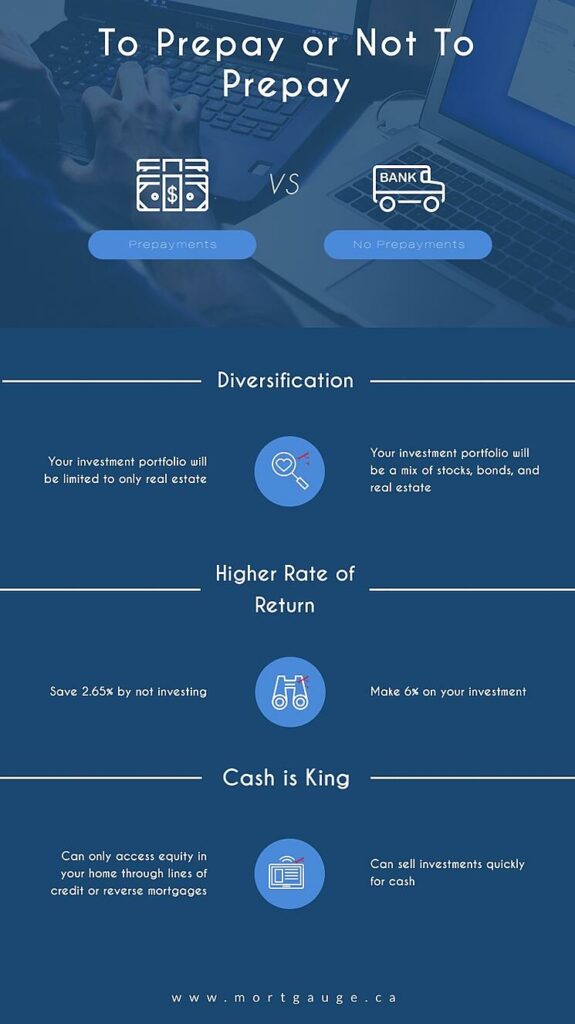If you are considering paying down your mortgage, keep reading!
When Mortgage Professionals Canada asked Canadians in 2019 if they would classify mortgages as “good debt”, Canadians agreed (7/10). At the same time, a lot of people set out on a mission to pay down their mortgage as quickly as possible. It made us ask why the mixed signals?
What is a Prepayment?
A prepayment is the ability to increase your monthly mortgage payments and/or make a lump sum payment against the principal of your outstanding mortgage balance each year without incurring a penalty. The industry standard is around 15% for either monthly payment increases or lump sum payments.
Why Pay Down Your Mortgage?
The number one reason people pay down their mortgage is simply to save on interest and become debt-free sooner. Interest savings can be pretty material over time. For example, if we run a $400,000 mortgage (2.65% rate) through our mortgage calculator without any prepayments, you’d pay roughly $148,100 in interest over 25 years. However, if you prepaid 10% of your mortgage balance each year, you’d only pay $69,419 in interest over 25 years That would be a savings of almost $80,000 over your mortgage’s lifetime!
What Are The Downsides To Paying Down Your Mortgage?
For the average household, you will need to choose to either pay down your mortgage or invest in other assets. Most Canadians can’t afford to do all at the same time.
Today, with a 20% down payment, our mortgage rate of 2.65% is a lot lower than the expected return a new home owner would want on an investment portfolio. Let’s say on average this is 6%. The implied excess return from paying down your mortgage compared relative to investing in another asset class is then -3.35% (2.65%-6%), which compounds over time.
By prepaying your mortgage instead of investing in other assets your investment portfolio would be 100% real estate. This lack of diversification leaves you over-exposed to the trends of the Canadian real estate market and could negatively impact you if a housing correction were to occur and you had no other assets to rely on.
It’s also important to remember that liquidity matters when you retire. Even if your home is worth over a million dollars, you can’t use that equity to buy groceries. If your net worth is completely tied up in your home, you will likely need to access it through either a home equity line of credit or a reverse mortgage. Instead of the 2.65% rate you’d pay on your mortgage, these loan products would be in the 4-6% rate range.
What Do The Numbers Say?
To outline these differences, we looked at the impact on net worth for an average Canadian household saving from 30 until 65 with the mortgage rates and expected return we discussed above. Someone who paid down their mortgage before starting to invest would be worth 6% less at 65 and would have a $500,000 retirement shortfall vs someone who chose to not prepay their mortgage and invest elsewhere. This means they’d need to access that $500,000 either through their home equity line of credit or a reverse mortgage when they run out of money at 4-6% interest rates.

What Do We Recommend?
Your first priority as a homeowner should be to meet your annual saving goals within a sheltered account (your RRSP and TFSA). If you max those out (well done!) then you can either prepay your mortgage up to your maximum allowable amount (typically 10-20% of the original principal, depending on the lender) or invest in non-sheltered accounts. Note that non-sheltered accounts are taxable, so your pre-tax return (assuming a 30% tax bracket) would need to be at least 3.1-5.3% to be more beneficial than paying down your mortgage of 2.65%.
What Are The Exceptions?
Rate Matters
In our example above, a key factor in the net worth differences without prepayments is because we expected a 6% return on investment vs a 2.65% mortgage rate. But if your mortgage rate is 5-6% (or higher), then the relative benefit is not nearly as high or could even be negative.
Limits Exist
Just like you have a maximum RRSP and TFSA contribution amount each year (which accumulates), your lender also has a maximum amount they’ll allow you to prepay without penalty. Make sure you know what those limits are to avoid over-contribution charges or prepayment penalties.
Know Your Habits
The example we outlined above assumes you’re following a disciplined investment contribution strategy instead of paying down your mortgage. We understand that this strategy isn’t for everyone. If you find saving a challenge, it may be in your best interest to increase your mortgage payments to avoid spending the excess monthly cash flow.
 Ali
Ali





